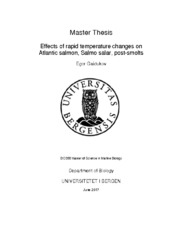Effects of rapid temperature changes on Atlantic salmon, Salmo salar, post-smolts
Master thesis
Permanent lenke
https://hdl.handle.net/1956/16321Utgivelsesdato
2017-06-28Metadata
Vis full innførselSamlinger
Sammendrag
Year round production of Atlantic salmon post-smolts in closed or semi-closed systems opens up for use of seawater from different depths, which will permit stocking of fish from closed containment system to the open sea cage at different seasons. This may be accompanied by greater temperature gradients, which in turn may result in growth depression, increased stress and mortality. In current study, post-smolts of 250 grams were directly transferred from 10°C to 13°C, 16°C and 18°C seawater. After 45 days weight and length increased significantly in all temperature groups, with no differences between rearing temperature. Post-smolt growth, measured as Thermal Growth Coefficient (TGC) in individually pit-tagged fish were lower in the 13, 16 and 18°C compared to the control (10°C) group. Markers for stress responsiveness (plasma cortisol, telencephalic CRF, CRFbp) and neural plasticity (telencephalic NeuroD and BDNF) were assessed following one and seven days’ temperature transfer and after acute confinement stress test (ACT). A transient 50-60-fold increase in plasma cortisol were observed in the 13 and 16°C groups following one and seven days’ transfer, while cortisol low in the 10 and the 18°C groups. After 45 days all temperature groups displayed low cortisol levels and responded to ACT by more than a 110-fold increase in plasma cortisol. Surprisingly only minor significant changes in CRF and CRFbp mRNA expression were found in response to abrupt changes in temperature, or in response to an acute challenges test in current study. There was up-regulation of telencephalic BDNF following acute challenge stress test in the 180C group. Taken together, our findings indicate that post-molts increase in size following direct transfer to higher temperatures, yet growth rate measured as TGC decrease with increasing temperature. Post-smolts responded well physiologically (cortisol) but displayed only limited (telencephalic BDNF) cognitively to temperatures, which raises concerns from an animal welfare perspective. It should also be emphasized that additional stressors such as handling should be taken into account and it is therefore recommended that direct transfer should not exceed a temperature gradient more 5°C when post-smolts are kept in the temperature range between 10 and 16°C.
